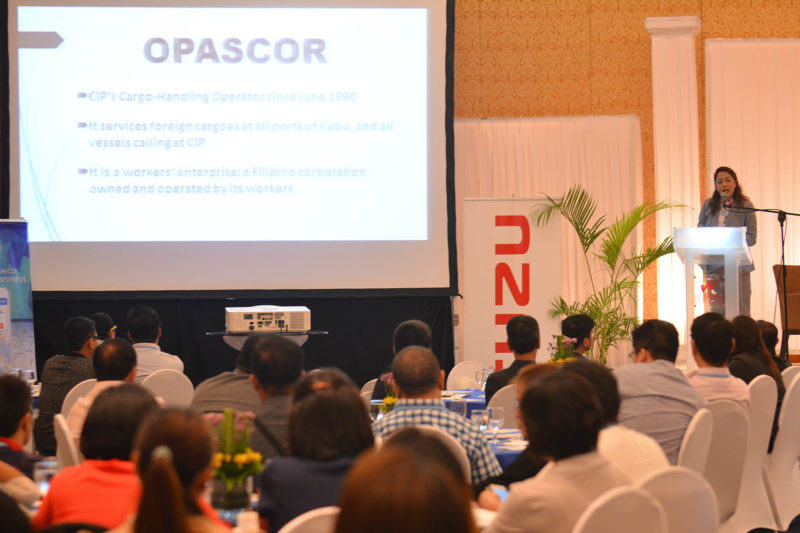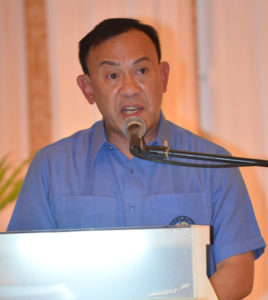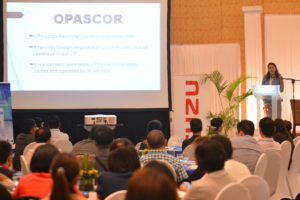

With the trade boom in the region, Cebu needs to establish a new container terminal in anticipation of bigger cargo volume and as a long-term solution to congestion at the existing hub, according to the Cebu Port Authority (CPA).
Despite improvements at the Cebu International Port (CIP), “the congestion at the CIP and its road network has become more serious due to increasing cargo volume,” CPA general manager Edmund Tan said during the first Visayas Shipping Conference 2016 recently organized by PortCalls and the Philippine International Seafreight Forwarders Association in Cebu City.
“For other cargoes, due to the very narrow apron area, congestion during the loading and unloading is much more serious. Therefore, the efficiency of cargo handling decreases and the safety of port operations will become an issue,” the CPA chief noted.
CIP has been experiencing berth and yard congestion since 2014 due to the increase in volume, high dwell time of containers, limited yard space and back up area, and truck bans. Tan said that although congestion these days is less serious than in 2014 due to some measures that have already been put in place, it could grow worse again come the peak season.
Tan said the proposed New CIP is “expected to provide a lasting solution to… congestion at the existing Cebu port and the shallow water depth of the Cebu international container berths.”
He explained that shipping companies find the depth at the wharf too shallow for efficient and economical international shipping. The international port has a controlling draft of only 9.5 meters at mean low-low water (MLLW), while the draft of the domestic terminal measures only 6.5 meters MLLW.
Study backs call for new hub
A recent feasibility study by the Export-Import Bank of Korea proposed the construction of the new international terminal in Tayud, Consolacion, about eight kilometers from the Cebu base port.
Tan noted that the study, completed in July 2015, validates the findings and recommendations of previous studies suggesting a new Cebu sea hub.
The study was submitted last year to CPA’s mother agency, the Department of Transportation and Communications (DOTC), for the secretary to approve and endorse to the National Economic and Development Authority (NEDA). Tan said NEDA is currently awaiting from DOTC the requisite documents that will facilitate NEDA Board-Investment Coordination Committee processing and approval.
Had the project been approved last January, Tan said construction would have been scheduled in August 2016. But even as the current administration’s term is ending, Tan said he believes that whoever wins the presidency “will pursue with this project.”
He urged the next administration not to start from scratch again but to take off from what the studies recommend.
The proposal calls for a new international container terminal with a project cost of P9.3 billion, and with features such as an operations building, container freight stations, a customs inspection section, a maintenance factory, and a substation for power supply.
Tan noted that the project has recently been included in NEDA’s Comprehensive and Integrated Infrastructure Program, with an implementation period of 2017-2020 to be financed via official development assistance. The Regional Development Council-Central Visayas Region through Resolution No. 55 (series of 2015) dated December 11, 2015 has endorsed funding the project through ODA.
Tan said the new port “will need the assistance of the Local Government of Consolacion and Department of Public Works and Highways” for an access road connecting it to the Cebu North Coastal Road.
Enhancements at CIP continue
While waiting for the new international port, CIP cargo handler Oriental Port and Allied Services Corporation (OPASCOR) said measures are being implemented to handle the growing volume at the port.

Dredging of the berthing and maneuvering areas is being undertaken by both OPASCOR and CPA, and a nearby area has been leased to hold containers abandoned by owners or seized by the Bureau of Customs (BOC) to free up space inside the terminal, according to OPASCOR legal and corporate development manager and chief legal officer Atty. Annabel Pulviera-Page, who also spoke at the Visayas Shipping Conference.
At the same time the primary stockyard will be expanded by the end of 2016 with two additional blocks. The cargo handler will also increase the number of reefer plugs, acquire an additional reach stacker, re-fleet prime movers, install more quay cranes and rubber-tired gantry cranes as well as additional CCTV cameras.
To further increase yard space, OPASCOR is continuously acquiring equipment with high-stacking capacity to maximize vertical space.
Some of the main goals of OPASCOR and CPA are to increase withdrawals and decrease dwell times. CPA last year implemented higher storage rates to discourage shippers from leaving their containers inside the port for long periods.
However, Page hopes for a “drastic improvement” once BOC implements its plan to have 24/7 operating hours at Cebu port.
CPA’s Tan noted that after the increase in storage rates, there have been changes in the behavior of shippers, with one company able to withdraw 500 containers in a day just to avoid paying charges.
Meantime, Tan said the port authority is almost finished with the first phase of Pier 4, an additional berth specifically catering to domestic shipments, which will help increase the berthing capacity of the terminal. Moreover, a fast-craft terminal is also in the pipeline to replace the one damaged by a strong earthquake in 2013. – Roumina Pablo




